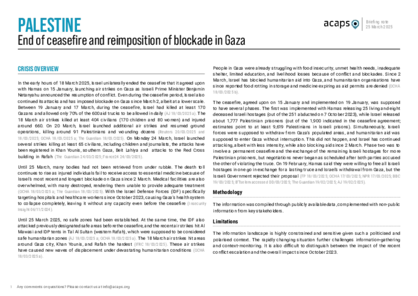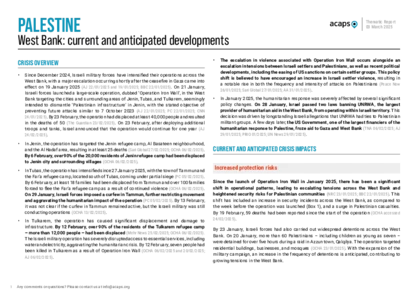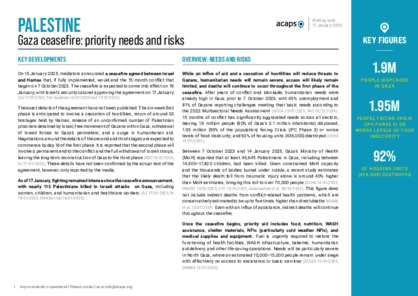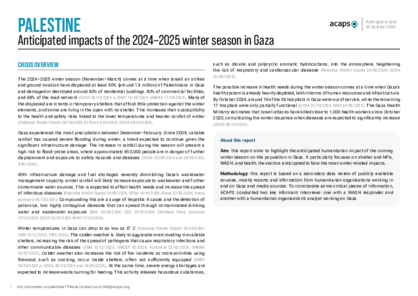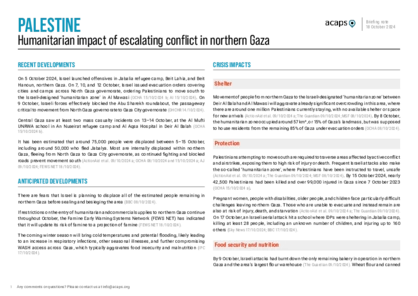Latest updates on country situation
14 January 2026
Israel-imposed access restrictions continue to limit the entry of medical supplies into Gaza, especially cancer treatment needed for at least 11,000–13,000 existing patients and 200 new cases diagnosed every month. It is estimated that cancer-related deaths have tripled since October 2023, especially following the destruction of the Turkish-Palestinian Friendship Hospital, the only specialised oncology healthcare facility. Medical evacuations are still not allowed as the Rafah border crossing is still closed. (AJ 09/01/2026, Health Cluster 18/12/2025, Al Quds 31/12/2025)
07 January 2026
Since Israel notified 37 INGOs that their registration had expired, requiring them to cease operations within 60 days across East Jerusalem, Gaza, and the West Bank, humanitarian conditions are likely to deteriorate further, particularly in Gaza during the winter months (from November 2025 to March 2026). Storms, heavy rainfall, and flooding affected at least 235,000 people between 10–23 December, collapsing 17 buildings and damaging approximately 42,000 tents. Cold temperatures and widespread infrastructure damage killed infants through hypothermia and heightened public health risks, including sewage overflows and the increased spread of acute watery diarrhoea and acute respiratory tract infections. The suspension of INGO operations would disrupt food distributions, shut down health facilities, disrupt shelter pipelines, and cut off life-saving nutrition services, as INGOs currently deliver more than half of all food assistance, support 60% of field hospitals, and implement 75% of shelter and NFI programmes. (NRC 02/01/2026, UNRWA 26/12/2025, OCHA 03/01/2026)
19 November 2025
Across the West Bank, 400 settler violence incidents were recorded in October 2025 – the second-highest number since 2006. Almost half targeted farmers during the olive harvest season, disrupting the livelihoods of at least 100,000 families. The incidents included beating, throwing stones, cutting down trees, stealing crops, and setting fire to agricultural land and properties. (ACLED 07/11/2025, UN 21/10/2025, Reuters 08/11/2025)
19 November 2025
Heavy rains between 13–15 November 2025 flooded roads and tents across Gaza, affecting over 13,000 families (around 70,000 people), mostly in Gaza city and northern Gaza. The heavy rains also further damaged sanitation systems that had already collapsed in the two years since the conflict escalation, resulting in sewage water mixing with rainwater and increasing the risk of disease outbreaks. Some people have sheltered in destroyed buildings at risk of collapse, endangering their lives. Gaza’s authorities report that 300,000 tents and mobile homes are required to cover shelter needs. UNRWA reports having shelter supplies enough for 1.3 million Palestinians, but Israeli restrictions continue to prevent the entry of these materials and other key needs despite the ceasefire agreement. Until March 2026, temperatures will continue to drop, and more rain is expected. More people will likely urgently need tents, mobile homes, mattresses, blankets, and winter clothes. (OCHA 17/11/2025, AJ 17/11/2025, STC 18/11/2025)
15 September 2025
On 9 September 2025, Israel ordered the estimated one million people in Gaza city to relocate to Al Mawasi in southern Gaza, before beginning a major ground assault on 16 September. By then, only an estimated 350,000 residents had relocated within the city, while 175,000 had fled. The ground assault is expected to last months. The designated ‘humanitarian zone’ of Al Mawasi is already overcrowded and lacks dignified shelter, clean water, and sanitation. Prior to the current influx, Al Mawasi only had one latrine for every 4,000 people. Vulnerable groups, including children under five and pregnant or breastfeeding women, face severe risks, with many at high risk of famine. Humanitarian organisations face severe access constraints, and a near-total Israeli blockade limits essential aid supplies. On 16 September, the UN Independent International Commission of Inquiry on the Occupied Palestinian Territory declared that Israel has committed genocide in Gaza. (CARE 13/09/2025, AA 16/09/2025, IPC 22/08/2025)
25 August 2025
Escalating violence in the Gaza Strip has collapsed the food system, with over 98% of cropland damaged and fishing banned. A complete halt of humanitarian and commercial food deliveries in March, followed by critically low volumes through July, has resulted in extreme food shortages. Despite Israel announcing a ‘tactical pause’ on 27 July, violence has continued, including air strikes, shelling, and shooting. In mid-August, famine was confirmed in the Gaza Strip, with over 640,000 people projected to face Catastrophe (IPC Phase 5) levels, over 1,140,000 in Emergency (IPC Phase 4) levels, and nearly 198,000 in Crisis (IPC Phase 3) levels between 16 August and 30 September. Acute malnutrition among children under five has tripled in Gaza and doubled in Deir Al Balah and Khan Younis governorates since May. By June 2026, an estimated 132,000 children are expected to be acutely malnourished, including 41,000 severe cases. Urgent needs include food, nutrition, health services, WASH, shelter, and NFIs. (IPC 22/08/2025, FAO 09/08/2025)
06 August 2025
A worsening liquidity crisis is heightening the food insecurity and malnutrition crisis in Gaza. The commission for withdrawing money has surged from 30% in May 2025 to 53% in August. People in need, particularly employees, business owners, and families dependent on remittances, are struggling to access cash and purchase basic food items, especially amid high inflation affecting all commodities. (Independent 04/08/2025, Amnesty International 02/05/2025, Euro-Med Monitor 25/04/2025)
current crises
in
Palestine
These crises have been identified through the INFORM Severity Index, a tool for measuring and comparing the severity of humanitarian crises globally.
PSE003 - Conflict in the West Bank
Last updated 27/11/2025
Drivers
Conflict/ Violence
Crisis level
Country
Severity level
3.5 High
Access constraints
4.0
PSE004 - Conflict in Gaza
Last updated 27/11/2025
Drivers
Conflict/ Violence
Crisis level
Country
Severity level
4.2 Very High
Access constraints
5.0
PSE002 - Multiple crises
Last updated 27/11/2025
Drivers
Conflict/ Violence
Crisis level
Country
Severity level
4.4 Very High
Access constraints
5.0
Analysis products
on
Palestine
25 March 2025
Palestine: end of ceasefire and reimposition of blockade in Gaza
DOCUMENT / PDF / 363 KB
On the evening of 17 March 2025, Israel unilaterally ended the ceasefire that it agreed upon with Hamas on 15 January, launching air strikes on Gaza. During the ceasefire, Israel had killed at least 170 Gazans and allowed only 70% of the 600 aid trucks to be allowed in daily. The 17 March air strikes killed at least 404 civilians and injured around 660.
Attached resources
03 March 2025
Palestine: current and anticipated developments in West Bank
DOCUMENT / PDF / 759 KB
Since December 2024, Israeli military forces have intensified their operations across the West Bank, with a major escalation occurring shortly after the ceasefire in Gaza came into effect on 19 January 2025
17 January 2025
Gaza ceasefire: priority needs & risks
DOCUMENT / PDF / 216 KB
On 15 January 2025, mediators announced a ceasefire agreed between Israel and Hamas that would end the conflict that began on 7 October 2023. While an influx of aid and a cessation of hostilities will reduce threats to Gazans, humanitarian needs will remain severe, access will likely remain limited, and deaths will continue to occur throughout the first phase of the ceasefire.
30 October 2024
Palestine: Anticipated impacts of the 2024−2025 winter season in Gaza
DOCUMENT / PDF / 2 MB
This report aims to highlight the anticipated humanitarian impact of the coming winter season on the population in Gaza. It particularly focuses on shelter and NFIs, WASH, and health, the sectors anticipated to face the most winter-related impacts.
Attached resources
18 October 2024
Palestine: Humanitarian impact of escalating conflict in northern Gaza
DOCUMENT / PDF / 143 KB
On 5 October 2024, Israel launched offensives in northern Gaza. It has been estimated that around 75,000 people were displaced between 5–15 October. Most are internally displaced within northern Gaza, fleeing from North Gaza to Gaza City governorate, as continued fighting and blocked roads prevent movement to south.


